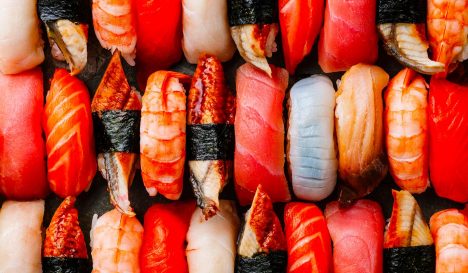Maki


Maki
-
Kitchen Japanese cuisine
-
Basis Rice
-
Dish type Side dish
-
Spiciness pepper pepper pepper
What is maki?
Maki is a form of sushi in which sushi rice – rice made with sushiu (sushi vinegar) – raw fish or vegetables are rolled up in a sheet of roasted seaweed. It’s one of the best-known forms of sushi.
Maki is also the umbrella name for all sushi rolls. There are four different styles of maki. Thin rolls of hosomaki contain a single filling, such as tuna or daikon, while futomaki has two or three fillings: fish and vegetables, for example. Both styles are also simply referred to as maki. There are also uramaki (inside out maki) and temaki (sushi cones).
Sushi was originally a street food. It soon became popular outside of Japan, particularly in Canada, where people were already used to buying food on the street. From there, sushi has become known all over the world as a snack, meal and a lunch dish.
Did you know...
The raw fish used in nigiri and maki is often allowed to ripen first. In this way, the true taste and umami of the fish are clearly accentuated.
How to make maki
Sushi literally means “vinegar rice” and the name shows how important rice is for all types of sushi. For sushi, short-grain Japanese white rice is used, which is slightly sticky so that the rolled rice stays in its shape. The rice is cooked and seasoned with sushi sui or sushi vinegar, a mixture of rice vinegar, sugar and salt. The result is sushi rice, also known as shari.
Sheets of nori (seaweed) are roasted by moving them briefly and quickly over a low flame by hand; first one side and then the other. During roasting, the colour becomes darker and the leaf firmer. Sheets of nori are supposed to be crispy and sweet-tasting with a melt-in-your mouth consistency.
For maki rolls, a sheet of nori is placed on a makisu (bamboo mat). The fish or vegetables are cut into strips of about twenty centimetres. The chef dips their fingers in a bowl containing water and a tablespoon of rice vinegar to prevent the rice from sticking to their hands. Clapping their hands to get rid of the excess moisture, they grab a handful of sushi rice and spread it evenly over the nori in a half-inch thick layer. This is followed by a thin line of wasabi and a bar of fish or vegetables. The chef rolls the entire sheet – filling and all – into a cylinder, using the mat. The roll is cut into six with a knife that has been pulled over a damp cloth.
Sushi is served with shoyu (soy sauce) and thin slices of pickled ginger.
How to eat maki
In Japan people used to eat sushi with their fingers, which makes sense when you consider that it was originally a street food. In expensive sushi restaurants, this is still sometimes the case, but many Japanese prefer to use chopsticks. Either way, dip the roll in soy sauce and put it in your mouth.
Please consider
Combine your maki into a real sushi dish with nigiri, gunkan and maybe even sashimi.





